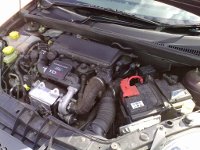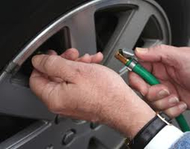Weekly Vehicle Checks
Vehicle maintenance should be carried out at least once a week and it's a good idea to keep your owner's manual to hand. Weekly vehicle checks are essential if you want to keep your car in tip-top condition and roadworthy.
There are certain items that need to be checked, they will be listed in your car manual and they are listed below:
Fluid Levels under the Bonnet
Engine Oil Level
Make sure the car is standing on level ground. Pull out the dipstick and wipe it clean with a non-fluffy rag. Re-insert the dipstick completly back into the engine and then remove it again. if the oil level lies between the MAX and MIN marks, there is no need to add any oil. If the oil is below the MIN mark then top up the oil level using the correct oil recommended by the car manufacturer. Only top up oil to the MAX mark.

If the oil pressure warning light on the dash illuminates when driving or doesn't switch off when starting the engine. Switch off the engine, and check the oil level. Do not carry on with your journey or restart the engine until the problem has been checked out by an expert.
Brake Fluid Reservoir
The level of the fluid must lie between the MAX and MIN marks. If not, ask an engineer to help – driving with low levels of brake fluid can be dangerous. Brake fluid should be changed every two years.
Engine Coolant Level
Ensure the tank isn’t hot, and use a cloth to remove the cap. Check the MIN and MAX levels on the coolant tank, if the level is below the MIN mark, fill up with water to the MAX mark. DO NOT attempt to unscrew the top if the engine is warm or hot.
In the winter it’s a good idea to use a 50/50 mixture of water and antifreeze, but take care as anti-freeze can burn your skin and ruin your car’s paintwork. This will help prevent freezing, which could crack your car’s engine block.
Washer Fluid
Make sure that your washer fluid bottle is full. Don't use washing up liquid as it can smear and lather too much - use a proper washer solution which can be bought quite cheaply from supermarkets, garages and car accessory shops.
Car Lights
Ensure that all lights are clean, that there is no cracked or damaged glass. Check that all lights - including headlights, sidelights, indicators, fog lights - all work and there are no bulbs that need replacing. This is easier to do with someone else as you can write a checklist before you go out to the car and get him or her to shout out instructions and confirm that each light is working properly before ticking it off the list.
Tyres
Tyres with low pressure or tread can be dangerous and impair your car’s handling. Here are two essential tyre checks:
1. Tyre pressure:

First make sure the tyres are cold, and remove the valve caps (small caps which twist off by hand from the outside of the tyre). Check the pressure level and adjust as necessary using a footpump or inflator with a reliable pressure gauge, before replacing the valve caps. Check your vehicle handbook for the correct tyre pressure.
2. Tread depth
Locate a tread wear marker – small squares found in the grooves of the tyre, and make sure your tyre’s tread depth is higher than this. If it’s lower, your tyres need changing. For a more accurate measure, use a tyre tread depth gauge.
A minimum tread depth of 1.6mm should be across the central three-quarters breadth of the tyre and the entire outer circumference. Any lower and your tyres will need changing. Look for any cuts, bulges and foreign objects stuck into the tyres (such as nails).
Windscreen Wipers
Make sure that the wiper blades are clean and don't drag across the windscreen. If there are lines or streaks across the window when you operate the wipers, then lift the wiper and clean the blade by wiping it with a cloth soaked in windscreen washer solution. If that doesn't work, it's time to replace the blade(s)
Battery
Car batteries generally last around four to five years.
Most batteries are maintenance free. It is only necessary to visually check the batteries physical condition, that connections are secure and that the battery is secure in the vehicle.
If your battery is dead you may have a faulty alternator, or damaged glow plugs (in certain diesel cars only) – so your battery may not need replacing. Check first.
